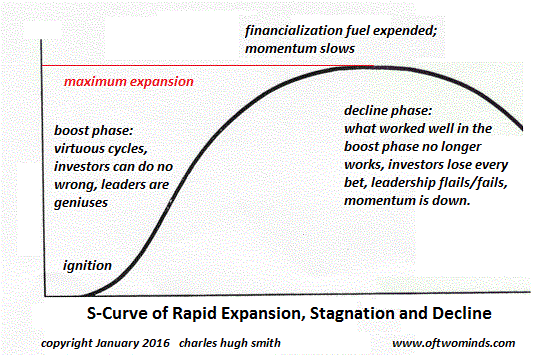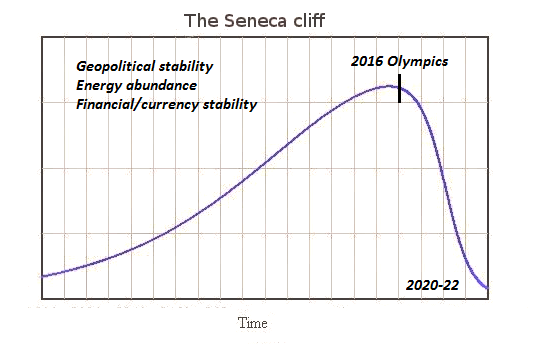Courtesy of Charles Hugh Smith, Of Two Minds
Two charts illustrate Why Our Status Quo Failed and Is Beyond Reform: this chart of the S-Curve of financialization, leverage, debt, central planning, regulatory capture and globalization–that is, the engines of modern "growth"–depicts the inevitable stagnation and decline of these dynamics as overcapacity, debt saturation and diminishing returns take hold.
This chart illustrates the status quo's insistence on doing more of what has failed spectacularly: since all this worked in the boost phase, the central planning Cargo Cult's "leadership" is convinced it will all work magically again, if only we do more of it.
Alas, this is magical thinking. One might as well paint radio dials on rocks and expect the rock to magically turn into a functioning radio.
The chart of the Seneca Cliff illustrates how the S-curve of "growth" can continue expanding even as the foundation weakens. As the foundations of real growth weaken– productivity, collateral, social mobility, etc.–the system become increasingly fragile and brittle. But this fragility is masked by the appearance of stability until a crisis cracks it wide open.
Normalcy crumbles into instability, and people and systems accustomed to stable supply chains and political stability struggle to maintain their grip on income streams and resources as abundance slips into scarcity and dependence on central planning becomes a liability of learned helplessness.
The S-curve:

Seneca Cliff:

There are two sets of solutions as stability and financialized "growth" slide into instability and DeGrowth.
1. Acquire skills that will be increasingly scarce and a network of collaborators, customers and suppliers who value/make use of these skills.
2. Create a new mode of production that doesn't rely on central banks, states and global finance to function: in effect, a decentralized, localized networked system that exists in parallel with the centralized hierarchies of the current mode of production which is centralized, industrialized, globalized, financialized, neofeudal, neoliberal, neocolonial, and dependent on ever-expanding leverage, debt, central planning, regulatory capture and fossil fuel consumption.
I describe the first set of solutions in my book Get a Job, Build a Real Career and Defy a Bewildering Economy.
The second set of solutions are the subject of my book A Radically Beneficial World: Automation, Technology & Creating Jobs for All.
Ultimately, these two sets of solutions are two facets of the only solution: a more sustainable, just, efficient, decentralized, transparent and opportunity-for-all mode of production.
Naysayers love to claim that these solutions can't possibly work for the usual array of reasons, which boil down to 1) my identity is dependent on poking holes in others' solutions or 2) my status and livelihood are dependent on the status quo continuing exactly as it is now or 3) an unexamined faith that the current mode of production is the only possible mode of production.
Note to naysayers: the "solution" that can't possibly work is the continuation of the status quo. There are only two pathways as the status quo arrangement destabilizes, decays and decoheres: 1) a doomed nostalgia for "solutions" that are no longer attainable (for example, Cargo Cults of "endless growth") or 2) an alternative set of solutions that are sustainable because they are localized, networked, democratized, opt-in and self-funded.
We are about to start a painful learning process about what is "impossible" and what is inevitable. Once it becomes self-evident that the current mode of production is not sustainable, we'll have no choice but to try more sustainable modes of production that are not just more efficient but that offer greater stability, opportunity and social mobility.




